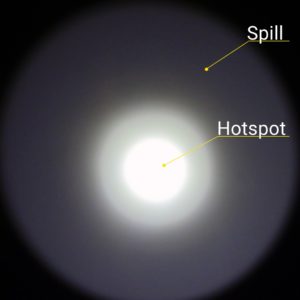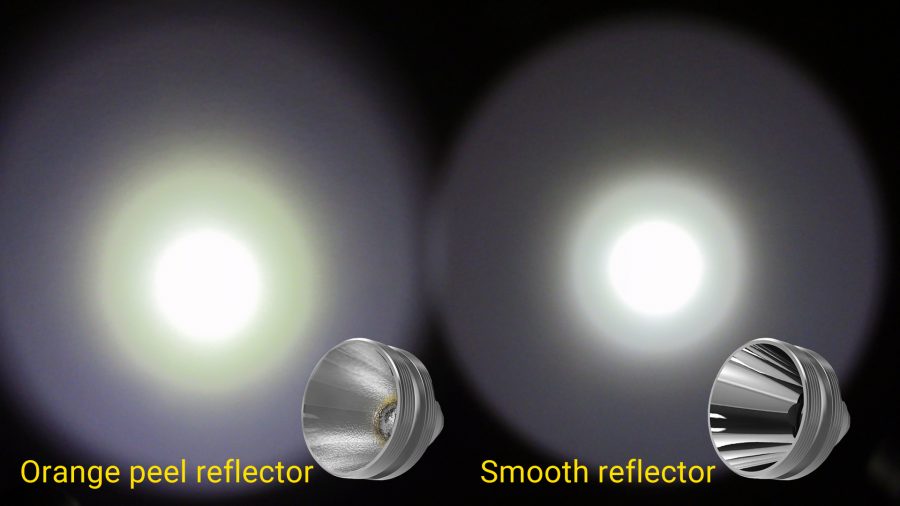Flashlight Beam Key Takeaways
- The hotspot is the center of the beam and the spill is the surrounding of the hotspot.
- A floody beam refers to a wide-angle beam while the thrower refers to a beam that projects a long distance.
- The shape of the reflector affects the beam.
- There are two main textures of the reflector: orange peel and smooth reflector.
The Flashlight Beam
Perhaps one of the trickiest things about buying a flashlight online is not knowing how the beam will look until it arrives at your door. Fortunately, with a little bit of knowledge, you can get a pretty good idea of the beam pattern your flashlight will produce just by reading the manufacturer specifications.
Keep reading for our beginner’s guide to flashlight beam profiles and learn what makes the difference between flood and throw.

Anatomy of a Flashlight Beam
Hotspot
When you shine a flashlight against a wall or other smooth surface, you’ll quickly notice two major areas of the beam profile. In the center of the beam is a circle of intensely bright output known as the hotspot.
Spill
Surrounding the hotspot, you’ll find a larger area of light known as the spill. This light will be noticeably dimmer than the hotspot and may form in a series of circles or a smooth wash of light depending on the flashlight reflector.
Flood vs. Throw
If you’ve read through different flashlight reviews, you’ve most likely come across these two terms repeatedly. In the flashlight world, flood refers to the area illuminated by the flashlight. When someone describes a flashlight as “floody,” they’re referring to a wide-angle beam that’s able to wash a surface in a smooth “flood” of light. These flashlights are great for up-close reading and general usage for their ability to evenly light up a space.
Want something with a very floody beam? Try one of our popular headlamps which are designed to illuminate a wide area in front of the wearer. Our favorite include:
NITECORE HC65UHE 2000 lumen headlamp
NITECORE NU25 400 lumen headlamp
On the flip side, you’ll often hear flashoholics talk about a flashlight that is a “thrower.” Here, throw is referring to the ability of the flashlight to project light at a distance. As you can guess, throw flashlights will have a very intense and focused hotspot that can be seen at greater distances. Some of the best throw flashlights are rated for distances well over 10 football fields long. Throwers are frequently the torch of choice for hunting, tactical, search, and law enforcement for this reason.
Try these NITECORE flashlights for long-throw beams:
NITECORE TM28 6000 lumen / 716 yrd long throw flashlight
NITECORE MH40 Pro 3500 lumen / 1421 yard long throw flashlight
Now that you have a grasp on the different parts of a flashlight beam and the basic terminology, let’s look at what determines the beam profile in the first place!
Flashlight Reflector Shape
With flashlights, it’s all about the reflector when it comes to beam profile. A general rule of thumb to follow here is the more elongated and deep a flashlight reflector is, the more throw distance will be possible. For a more floody beam, you’ll want to stick with a flashlight that uses a more shallow and wide reflector.
Flashlight Reflector Texture
Not only does the shape of the reflector matter, but reflector texture also plays a role in determining a flashlight’s throw capability and beam profile: the smoother a reflector’s surface, the more throw distance the flashlight will be capable of. Below are some of the frequent designations given to describe a reflector’s texture:

SMO
Otherwise known as Smooth, you’ll see these reflectors on throw flashlights and other flashlights with a very focused center. As you can guess, the surface on these is polished smooth like a mirror.
A vast majority of NITECORE flashlights feature a smooth reflector. Some of our absolute favorites include:
NITECORE E4K 4400 lumen USB-C rechargeable flashlight with SMO reflector
NITECORE MH12 Pro 3300 lumen USB-C rechargeable flashlight with SMO reflector
OP
More common on everyday carry, general use, and floodlights, OP stands for orange peel because of the texturing given to the reflector and its similarity to an orange peel. OP texture helps to smooth out light artifacts and creates even lighting. Sometimes you’ll see designations such as LOP (light orange peel) and MOP (medium orange peel) which further describe the amount of texturing detail.
Looking for a NITECORE flashlight with an orange peel reflector? Try these models:
NITECORE EDC27 UHi 3100 lumen Ultra Slim Flat flashlight with OP reflector
NITECORE MT10C 920 lumen EDC flashlight with OP reflector
What about a TIR Lens?
Flashlights that rely on the reflector shape to produce the desired beam pattern will feature a flat lens, often including anti-glare coating and ultra-clear properties to maximize light output as much as possible.
LED Output & Intensity
This last one might seem obvious, but the LED itself will also have an effect on a flashlight’s beam profile. While some LEDs are designed to maximize the total lumen output, others are engineered to support high-intensity applications.
CREE, one of our favorite LED suppliers, designates its brightest LEDs with HD (high density) and the most intense LEDs with HI (high intensity) at the end of the model names. For example, the CREE XHP35 HD is featured on some of our brightest flashlights like the Concept 2, while the CREE XP-L HI V3 has been a perpetual upgrade on our GT (Grand Throw) flashlights.


Cool post! I think the TINI has a TIR lens right? The new MT21C is pretty wide beam too. Might want to add about the corona the transition between the spot and the spill.
I own a nitecore p23i (great light) but in the direct center of the hotspot is a little “mild” darkening to it. Is that normal?
Hi there Matthew! This is totally normal for the P23i! That small shadow in the middle of your hotspot is due to the positioning of the LED and the reflector in the P23i. You can see this more dramatized if you were to hold you flashlight an inch away from a a solid object and see that shadow is just your LED. Many people refer to this as a flashlight donut hole. If you have any more questions please feel free to contact our customer support via our email support@nitecorestore.com or call us at (512) 258-6649